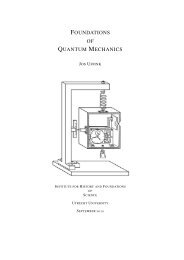Subjective probability and statistical physics
Subjective probability and statistical physics
Subjective probability and statistical physics
Create successful ePaper yourself
Turn your PDF publications into a flip-book with our unique Google optimized e-Paper software.
subject to the constraints 3<br />
∫<br />
o i =<br />
Γ<br />
O i (x)ρ(x)dx i = 1, . . . , n. (18)<br />
Between time t 0 <strong>and</strong> t 1 , the system undergoes some adiabatic process, e.g. with a<br />
time-dependent Hamiltonian. Solving Liouville’s equation with ρ 0 as initial condition,<br />
we obtain the later distribution ρ 1 . Use this distribution to calculate<br />
∫<br />
o ′ i := O i (x)ρ 1 (x)dx i = 1, . . . , n. (19)<br />
Γ<br />
Now we allow the system to equilibrate, <strong>and</strong> calculate a new distribution ˆρ 1 by maximizing<br />
the Gibbs entropy subject to the constraints<br />
∫<br />
o ′ i = O i (x)ρ(x)dx i = 1, . . . , n. (20)<br />
Γ<br />
Now, since the Gibbs entropy is invariant under the evolution by Liouville’s equation,<br />
it is clear that S G (ρ 0 ) = S G (ρ 1 ). But it is also clear that since ρ 1 is just one of the<br />
distributions that satisfy the constraints (20), we also have S G (ρ 1 ) ≤ S G (ˆρ 1 ). Hence:<br />
S G (ρ 0 ) ≤ S G (ˆρ 1 ), which, according to Jaynes proves the Second Law, i.e. entropy<br />
cannot decrease during adiabatic processes.<br />
The argument has been criticised by several commentators before (Lavis & Milligan<br />
1985, Earman 1986, Parker 2006) To me the main weakness seems to be to<br />
reference to a supposed process of equilibration. There is, of course, no dynamically<br />
allowed process that will transform the distribution from ρ 1 into ˆρ 1 with higher Gibbs<br />
entropy. Therefore, the assignment of ˆρ 1 can only be justified by a conscious decision<br />
to ignore or throw away information: namely the known values of the observables<br />
at an earlier time. But to derive an increase of entropy from a decision to ignore<br />
information one actually has, seems a strategy that both runs counter to the spirit<br />
of the neo-classical program <strong>and</strong> at the same time be unconvincing as a derivation of<br />
the second law, at least for those authors who feel that this represents an objective<br />
law of nature.<br />
To sum up, a subjective view on <strong>probability</strong> in <strong>statistical</strong> <strong>physics</strong> is clearly a<br />
viable view to take, when dealing with ensembles. But substantial issues within<br />
this approach remain: whether one takes a Bayesian, a de Finettian or a Jaynesian<br />
approach on how to model the impact of empirical evidence. To me, De Finetti’s<br />
approach is by far the most appealing. Moreover, claims that such a subjective view<br />
solves or dissolves the problems that appear in an objective view on probabilities in<br />
<strong>statistical</strong> <strong>physics</strong> are in my opinion premature.<br />
References<br />
Bayes, T. (1763). Essay towards solving a problem in the doctrine of chances. Philosophical<br />
Transactions of the Royal Society of London 53, 370–418; reprinted in<br />
Biometrika 45, pp. 293-315 (1958), <strong>and</strong> Two Papers by Bayes, with commentary<br />
by W. Edwards, (Deming, New York: Hafner, 1963).<br />
3 Note how, here too, Jaynes interprets observed data as constraints on probabilities, in defiance<br />
of the sharp boundary between the two proclaimed in the passage cited above.<br />
21
















